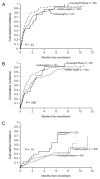Effect of body mass index on the outcome of children with acute myeloid leukemia
- PMID: 22648558
- PMCID: PMC3434283
- DOI: 10.1002/cncr.27640
Effect of body mass index on the outcome of children with acute myeloid leukemia
Abstract
Background: The effect of body mass index (BMI) on the treatment outcomes of children with acute myeloid leukemia (AML) is unclear and needs further evaluation.
Methods: Children with AML (n = 314) who were enrolled in 4 consecutive St. Jude protocols were grouped according to BMI (underweight, <5th percentile; healthy weight, 5th to 85th percentile; and overweight/obese, ≥ 85th percentile).
Results: Twenty-five patients (8%) were underweight, 86 patients (27.4%) were overweight/obese, and 203 patients (64.6%) had healthy weight. The 5-year overall survival rate of overweight/obese patients (46.5% ± 7.3%) was lower than the rate of patients with healthy weight (67.1% ± 4.3%; P < .001); underweight patients also tended to have lower survival rates (50.6% ± 10.7%; P = .18). In a multivariable analysis that was adjusted for age, leukocyte count, French-American-British classification, and study protocols, patients with healthy weight had the best survival rate among the 3 groups (P = .01). When BMI was considered as continuous variable, patients with lower or higher BMI percentiles had worse survival (P = .03). There was no difference in the occurrence of induction failure or relapse among BMI groups, although underweight and overweight/obese patients had a significantly higher cumulative incidence of treatment-related mortality, especially because of infection (P = .009).
Conclusions: An unhealthy BMI was associated with worse survival and more treatment-related mortality in children with AML. Meticulous supportive care with nutritional support and education, infection prophylaxis, and detailed laboratory and physical examination is required for these patients. These measures, together with pharmacokinetics-guided chemotherapy dosing, may improve outcome.
Copyright © 2012 American Cancer Society.
Conflict of interest statement
There is no conflict of interest.
Figures




Similar articles
-
Association between body mass index at diagnosis and outcomes in Chinese children with newly diagnosed acute lymphoblastic leukemia.Cancer Med. 2023 Feb;12(3):2850-2860. doi: 10.1002/cam4.5188. Epub 2022 Sep 27. Cancer Med. 2023. PMID: 36168702 Free PMC article.
-
Mortality in overweight and underweight children with acute myeloid leukemia.JAMA. 2005 Jan 12;293(2):203-11. doi: 10.1001/jama.293.2.203. JAMA. 2005. PMID: 15644547 Clinical Trial.
-
[The Relationship between Body Mass Index and Adult Acute Myeloid Leukemia].Zhongguo Shi Yan Xue Ye Xue Za Zhi. 2021 Jun;29(3):677-684. doi: 10.19746/j.cnki.issn.1009-2137.2021.03.004. Zhongguo Shi Yan Xue Ye Xue Za Zhi. 2021. PMID: 34105456 Chinese.
-
Underweight status at diagnosis is associated with poorer outcomes in adult patients with acute myeloid leukemia: a retrospective study of JALSG AML 201.Ann Hematol. 2018 Jan;97(1):73-81. doi: 10.1007/s00277-017-3156-x. Epub 2017 Dec 2. Ann Hematol. 2018. PMID: 29196987
-
Obesity in pediatric oncology.Pediatr Blood Cancer. 2005 Dec;45(7):881-91. doi: 10.1002/pbc.20451. Pediatr Blood Cancer. 2005. PMID: 16035086 Review.
Cited by
-
Body mass index and infectious disease mortality in midlife in a cohort of 2.3 million adolescents.Int J Obes (Lond). 2018 Apr;42(4):801-807. doi: 10.1038/ijo.2017.263. Epub 2017 Oct 30. Int J Obes (Lond). 2018. PMID: 29081504
-
Lack of Effectiveness of Neutropenic Diet and Social Restrictions as Anti-Infective Measures in Children With Acute Myeloid Leukemia: An Analysis of the AML-BFM 2004 Trial.J Clin Oncol. 2016 Aug 10;34(23):2776-83. doi: 10.1200/JCO.2016.66.7881. Epub 2016 Jun 6. J Clin Oncol. 2016. PMID: 27269945 Free PMC article. Clinical Trial.
-
Changes in body mass index, weight, and height in children with acute myeloid leukemia and the associations with outcome.Blood Adv. 2022 May 10;6(9):2824-2834. doi: 10.1182/bloodadvances.2021006090. Blood Adv. 2022. PMID: 35196375 Free PMC article.
-
Clinical implications of malnutrition in childhood cancer patients--infections and mortality.Support Care Cancer. 2015 Jan;23(1):143-50. doi: 10.1007/s00520-014-2350-9. Epub 2014 Jul 11. Support Care Cancer. 2015. PMID: 25011521
-
Longitudinal changes in body mass index, height, and weight in children with acute myeloid leukemia.BMC Pediatr. 2024 Apr 30;24(1):293. doi: 10.1186/s12887-024-04740-z. BMC Pediatr. 2024. PMID: 38689235 Free PMC article.
References
-
- Tsukimoto I, Tawa A, Horibe K, et al. Risk-stratified therapy and the intensive use of cytarabine improves the outcome in childhood acute myeloid leukemia: the AML99 trial from the Japanese Childhood AML Cooperative Study Group. J Clin Oncol. 2009;27(24):4007–13. - PubMed
-
- Grimwade D, Hills RK. Independent prognostic factors for AML outcome. Hematology Am Soc Hematol Educ Program. 2009:385–95. - PubMed
-
- Lange BJ, Gerbing RB, Feusner J, et al. Mortality in overweight and underweight children with acute myeloid leukemia. JAMA. 2005;293(2):203–11. - PubMed
-
- Arnaout MK, Radomski KM, Srivastava DK, et al. Treatment of childhood acute myelogenous leukemia with an intensive regimen (AML-87) that individualizes etoposide and cytarabine dosages: short- and long-term effects. Leukemia. 2000;14(10):1736–42. - PubMed
Publication types
MeSH terms
Grants and funding
LinkOut - more resources
Full Text Sources
Medical

